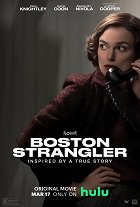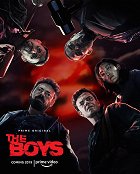Rikos - Genret
Suosituin suoratoistopalveluissa tänään
Characteristics and subtypes of crime films
Crime is a fictional film genre that depicts the motif of crime in various forms and from various perspectives. Its roots are in crime literature, which consists of stories of criminals, police officers or detectives unravelling mysterious murders, kidnappings, robberies, etc. The most common protagonist of crime films is therefore an investigator, usually a plainclothes police detective, a private or an amateur detective who usually gets involved in criminal cases because they are driven to do so by circumstances. More rarely, the protagonists are uniformed police officers and other specialists, such as forensic analysts or pathologists, and possibly also people in related professions, such as secret service agents or journalists, who go off on their own, usually in an attempt to uncover a juicy case. In some cases, the hero or heroine are victims of a crime, trying to defend themselves from their attackers and coping with the hardships. Against them stands the figure of the perpetrator, typically a thief, murderer or kidnapper, who sometimes, instead of an individual, can be a group of criminals, the mafia or a gang.
Crime films are based on uncovering and gradually unravelling a crime shrouded in mystery. The perpetrator may be unknown to the viewer until the last moment, and the story culminates with his revelation, but their identity may also be apparent from the start, and the only question is whether the protagonist will be able to track down and catch them. While working with and building tension is an integral part, as is the case with many thrillers, dramas, horror films and other genres, crime films, in contrast, emphasise the criminal aspects of the story, such as the investigation, the search for the perpetrators and the examination of the causes of the crime. Hence the reason for the long-lasting popularity of the genre – the simple fascination with crime and the transgression of social mores, the desire to take on the role of the criminal, the experience of exciting situations and the confrontation with curiosity-inducing motifs applied to a universal story about the battle between good and evil. Moreover, many crime films are inspired by real events, while others are often adaptations of well-known literary texts.
The most common subtype of crime film is the whodunit, in which the character of the detective-narrator is called upon to solve a perplexing case, the final resolution of which depends on the connection of a number of clues with seemingly unimportant details that eventually lead to the discovery of the culprit in front of the audience, made up of the other participants in the action. In a broader sense, the term whodunit is used to refer to any narrative structure consisting of the gradual unravelling of a true, hitherto unrecognized state of affairs. Another subtype is the gangster film, in which the main anti-heroes are representatives of the other side of the law: mobsters, organized criminals and gang members trying to avoid criminal responsibility for their activities. Police and heist films revolving around the planning and execution of big heists are also common. Prison films, focusing on life behind bars, inmate revolts and escape attempts, and film noir, which differ from other crime films by their formal stylization and specific atmosphere, are also often classified in the crime genre. In relation to the connection of crime film with other genres, we can also talk about crime-dramas, crime-thrillers, crime-comedies and crime-parodies, which turn common crime motifs on their head and use them to entertain the audience.
Silent crime films
The silent era produced few titles that can be considered crime films, although some of their hallmarks have been present in cinema since its early days; for instance, the short The Arrest of a Pickpocket (1895), which depicts the capture and handcuffing of a pickpocket, or Sherlock Holmes Baffled (1900), the first ever cinematic depiction of the famous detective (confronting a disappearing thief). There were other films that depicted the activities of criminal outlaws, thieves and gunslingers, and a number of westerns featuring bandits, sheriffs and armed train robbers had similar themes (for example, The Great Train Robbery of 1903, the first full-feature western in film history).
Later crime films were inspired by urban crime – one of the first was D. W. Griffith's The Musketeers of Pig Alley (1912), a seventeen-minute film about street gangs set in a New York slum. A similar theme was chosen by director Raoul Walsh, who in 1915 made Regeneration, which with its seventy-two minutes already reached feature length and became a precursor of future gangster films; The Penalty (1920), on the other hand, was set in the criminal underworld of San Francisco led by the legless gangster Blizzard. Fritz Lang's German expressionist epic Dr. Mabuse: The Gambler (1922) told the story of a master criminal who tried to take over the world.
In the 1920s, gangster films in America were heavily influenced by Prohibition, when bootleggers, mafia clans and speakeasy operators profited from the sale and distribution of illicit alcohol, and the original intention to reduce crime was met with exactly the opposite effect. At the time, organized crime was the subject of films such as the silent The Racket (1928) and, most notably, Underworld (1927), which became a surprise hit and was the first official gangster film in history, defining the sub-genre's elements with its emphasis on a mafia boss in the lead role, hostile-looking dark alleys, and a police intervention finale in which the tragic anti-hero eventually falls into the hands of justice. Since then, crime and gangster films have become a dominant and immensely popular genre of American filmmaking.
Tri Mabuse - ihmispeto (1922)
Kuva © Universum Film (UFA)
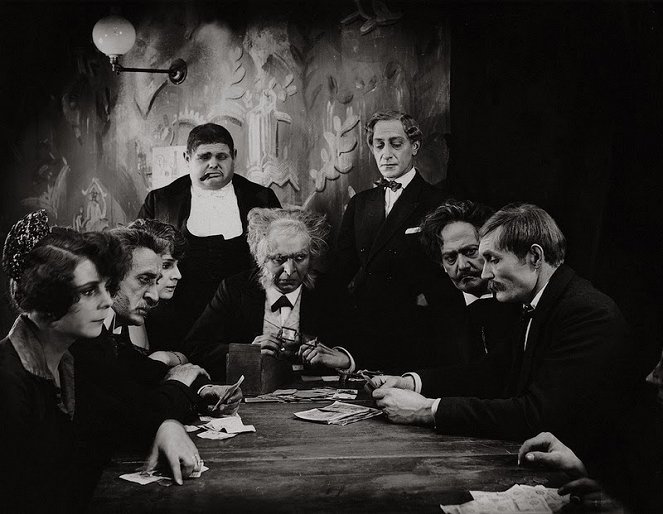
Gangster films from the beginning of the sound era
Gangster (or mafia) films fully developed with the advent of sound, as the atmosphere of the criminal world was enhanced by gun shots and harsh slang dialogue. The late 1920s and early 30s saw the release of Thunderbolt (1929) and The Doorway to Hell (1930), which dealt directly with the themes of Prohibition and the liquor trade, and Rouben Mamoulian's City Streets (1931), whose protagonist was drawn into the criminal underworld the moment he began working for a mob boss. This is the time when American filmmakers were beginning to face censorship after the establishment in 1930 of the Production Code according to which blasphemy, drug dealing and prostitution, among other things, were undesirable for cinema screens, and some states also rejected movies depicting excessive violence. The Great Depression also hit in the early 1930s, driving many people into economic and subsistence hardship, leading American society to believe that large financial turnarounds could only be achieved through criminal activity. Real-life mobsters and gangsters of the time, such as Al Capone and John Dillinger, became celebrities, and the numerous gangster films contributed to the public's tendency to idolise members of the criminal world.
In 1931 and 1932 alone, over fifty gangster films were produced. These included huge hits like Mervyn LeRoy's Little Caesar (1931), describing the rise and fall of a mob boss inspired directly by Al Capone, and William A. Wellman's The Public Enemy (1931), whose main anti-hero rose from common hitman to prominent gangster. In order to avoid influencing public opinion too much in favour of criminals, The Public Enemy even included a warning in its prologue that mobsters and criminals are not heroes to be cheered, quite the opposite. Howard Hawks's Scarface (1932), inspired by Al Capone, was also a big hit and, in addition to its undeniable qualities, stood out above the competition for its high level of violence.
Prohibition ended in the USA in 1933, and a year later the Production Code was tightened, both of which led to a decline in gangster films (the end of interest in the gangster film in Hollywood is well reflected, for example, in Raoul Walsh's 1939 film The Roaring Twenties, about a war veteran turned liquor smuggler). From then on, criminals had to be portrayed as villains and the law always had to prevail, so it was no longer so fashionable to make films with mobsters in the lead roles. Even so, gangster films continued to be made and many of them were very profitable, but the criminals now had moved to supporting roles in most of them and the main characters became detectives and law enforcement officials. These rules remained in force until 1966, when the code was abolished and replaced in 1968 by the MPAA film rating still in use today.
Arpinaama (1932)
Kuva © United Artists
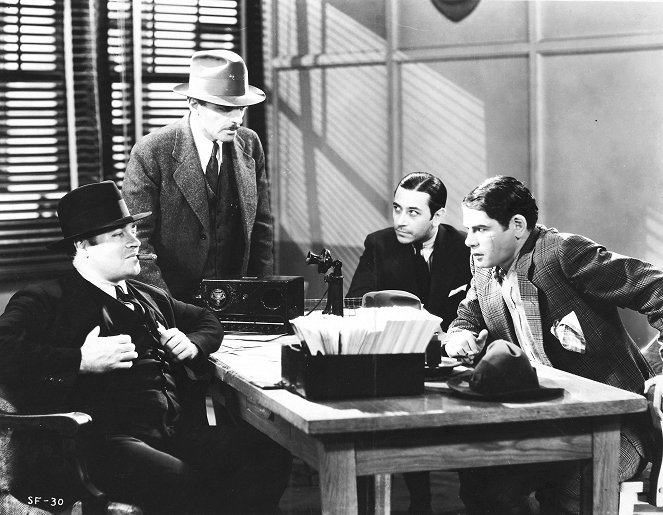
Prison and other crime films of the 1930s
While gangster films realistically reflected the atmosphere of the decay and crises of the 1930s, prison films and their protagonists were locked in a specific world in which the system and justice still seemed to work perfectly. The emergence of this sub-genre was sparked by the Ohio prison fire of 1930, during which several hundred inmates were burned to death, leading some filmmakers to depict the inhumane conditions that prevailed in many penitentiaries. Some prison films were set inside prisons, with convicts wearing striped uniforms and going about their daily routines (e.g. The Big House from 1930, about the suppression of a prison riot). Others favoured outdoor locations with chained prisoners forced to do hard labour under the blazing sun (such as I Am a Fugitive from a Chain Gang from 1932, which featured another common motif in prison films: escape from captivity). These were followed by The Criminal Code (1931), Day of Reckoning (1933) and San Quentin (1937), among others.
In addition, films starring a Chinese-American detective named Charlie Chan became popular, with more than a dozen of them being made during the 1930s (e.g. Charlie Chan in London in 1934, Charlie Chan in Egypt in 1935 and Charlie Chan's Secret in 1936). Their success led rival studios to create similar multi-part film series featuring Asian investigators, like Mr. Moto (Think Fast, Mr. Moto, 1937) and Mr. Wong (Mr. Wong, Detective, 1938).
Investigative lawyer Perry Mason (1935's The Case of the Curious Bride), reporter Torchy Blane (1937's Smart Blonde) and detective Philo Vance (1929's The Canary Murder Case) also repeatedly roamed the silver screen. Also successful was the "Thin Man" film series about detective Nick Charles, played by William Powell (1934's The Thin Man, 1936's After the Thin Man), which combined crime plots with comedy. The Mayor of Hell (1933) turned the trend of prison films into a crime-drama about juvenile delinquents in a detention centre. In The Petrified Forest (1936), Humphrey Bogart (one of the busiest and most popular actors of the 1930s and 40s) played the character of a murderer inspired by John Dillinger, and Invisible Stripes (1939), depicting the divergent fates of two released prisoners, told the story of the impossibility of ex-convicts to return to an honest life.
Kivettynyt metsä (1936)
Kuva © Warner Bros. Pictures
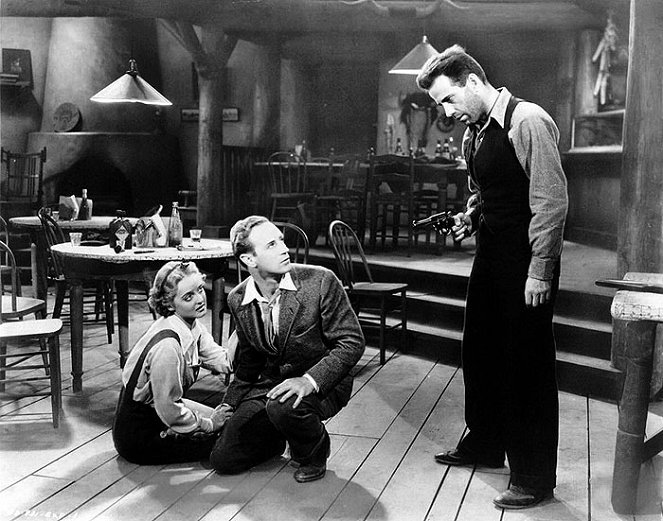
Film noir and its predecessors
The term "film noir" is used to describe films that fulfil certain characteristic stylistic and content features of American crime films, especially in the 1940s and 50s. Cinema at that time was still influenced by the wave of 1930s gangster films (criminals and detectives, firearms, nightclubs and bars, modern cities with dark alleys, run-down hotels, cars, alcohol...), and the Second World War also left its mark, bringing feelings of confusion, fear and anxiety. Film noir successfully reflected this mood with its cynical and pessimistic atmosphere, which was complemented by the pervasive corruption, disillusionment and paranoia caused by the onset of the Cold War.
Other significant influences on film noir were German expressionism (especially in terms of composition and the use of light and shadow), French poetic realism and Italian neo-realism (some directors were European immigrants), gritty detective novels by American writers (especially James M. Cain, Raymond Chandler, Cornell Woolrich and Dashiell Hammett), but also the innovative formal and narrative techniques used in Orson Welles's Citizen Kane (1941), especially the narrative through flashbacks. The typical hero (or anti-hero) of these films was a private detective, often a war veteran, an ordinary person on the edge of the law, or an innocent victim of circumstance. Another essential character was often a fateful seductive woman (the so-called femme fatale) in a leading or supporting role, treacherously enticing the male protagonist to participate in a crime and enriching the film with themes of amorality and sexuality, but also of calculation and intrigue.
Although John Huston's The Maltese Falcon (1941), starring Humphrey Bogart as a private detective turned murder suspect, is commonly considered the first official film noir, many earlier films exhibited some of the characteristics of the genre. Rouben Mamoulian's aforementioned City Streets (1931), for example, is often cited as one of the forerunners of film noir, as are Fritz Lang's trilogy Fury (1936), You Only Live Once (1937) and You and Me (1938), which dealt with the themes of the reintegration of ex-convicts into society and the false accusations of people wrongly judged by an outraged community. Stranger on the Third Floor (1940), which featured a witness to a murder who was haunted by doubts about the killer's identity, also had film noir qualities.
Maltan haukka (1941)
Kuva © Warner Bros. Pictures
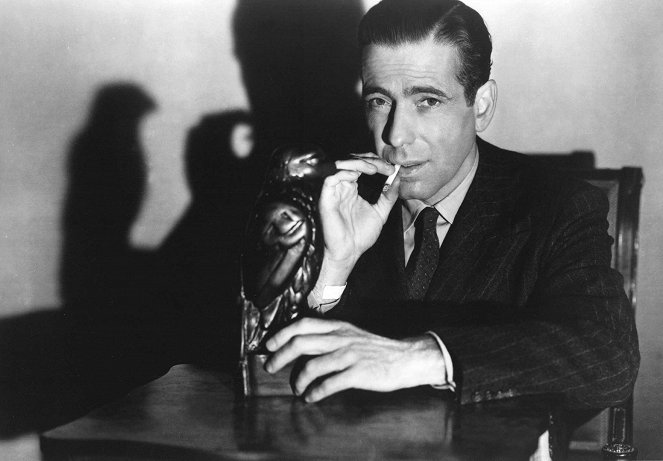
Notable representatives of film noir
One of the most influential film noirs was Billy Wilder's seven Oscar-nominated Double Indemnity (1944), the story of a hardened woman who, along with her insurance agent lover, decides to kill her husband to get rich on his life insurance. Billy Wilder went on to make the four Oscar-winning The Lost Weekend (1945), the journalistic manipulation story Ace in the Hole (1951) and, most notably, the celebrated Sunset Boulevard (1950), a satirical portrait of Hollywood's backstage about the superficiality of fame and faded movie stars, which took in three of its eleven Oscar nominations. Another important film noir figure was actor, director and screenwriter Orson Welles, who made, among others, The Stranger (1946), The Lady from Shanghai (1947) and Touch of Evil (1958), in which he also portrayed an unscrupulous sheriff who tailors the cases he investigates to his own liking. Welles also played a man faking his own death in Carol Reed's British film The Third Man (1949), set in post-war Vienna.
In addition to Billy Wilder, other native European directors made a name for themselves in Hollywood thanks to film noir. Robert Siodmak made his mark with Phantom Lady (1944), the first film noir to feature a female protagonist, and later directed The Killers (1946), The Dark Mirror (1946) and Cry of the City (1948). Otto Preminger burst onto the scene with Laura (1944), about a murder investigation, and continued his career with Fallen Angel (1945), Whirlpool (1949) and Where the Sidewalk Ends (1950). Fritz Lang's Scarlet Street (1945) and Human Desire (1954) were both remakes of French films from the 1930s, and The Big Heat (1953) is another film of his worth mentioning. Film noirs were also made by Edgar G. Ulmer (1945's Detour), Jacques Tourneur (1947's Out of the Past) and Michael Curtiz, whose Mildred Pierce (1945), about an emancipated woman who goes into business in pursuit of the American dream and then decides to sacrifice herself for her daughter, earned Joan Crawford the Academy Award for Best Actress in a Leading Role.
Other notable titles of the film noir era include Jules Dassin's Brute Force (1947), The Naked City (1948) and Night and the City (1950), and Robert Wise's Born to Kill (1947) and The Set-Up (1949), which features an unsuccessful boxer whose fate is shaken by a sudden win. Edward Dmytryk's Murder, My Sweet (1944) starred the famous detective Philip Marlowe, played by Dick Powell, investigating a murder committed while handing over a ransom note for a stolen jewel. The same character was later played by George Montgomery in The Brasher Doubloon (1947), Robert Montgomery in his own subjectively narrated film Lady in the Lake (1947), and Humphrey Bogart in Howard Hawks's The Big Sleep (1946), which dealt with a complicated blackmail case. In Nicholas Ray's In a Lonely Place (1950), Humphrey Bogart played a film scriptwriter suspected of murder.
In Charles Laughton's visionary and visually playful The Night of the Hunter (1955), with a crime plot involving the search for hidden loot combined with an almost fairy-tale parallel of good and evil, a diabolical villain pursues a pair of children in order to coax from them the location of the sought-after loot. In Tay Garnett's The Postman Always Rings Twice (1946), a pair of lovers get into trouble by committing murder together; in Gilda (1946), a beautiful singer is responsible for the disgrace of two friends; and in The Blue Dahlia (1946), a war veteran is suspected of murdering his unfaithful wife after returning from the front. Gun Crazy (1950), a film about lovers on the run from the law, is famous for a robbery scene filmed from inside a car in one long take.
Gangsterikuningas (1953)
Kuva © Columbia Pictures
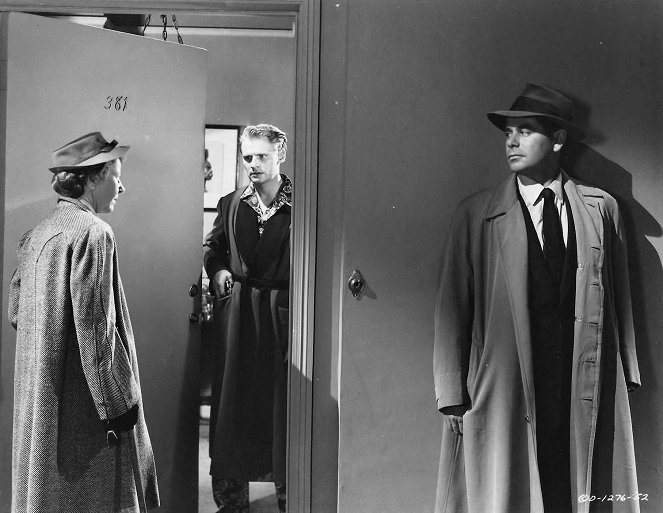
Whodunits and other crime films of the 1940s
The pressures of censorship and the demands on crime films resulted in filmmakers having to tailor their works to portray villains as unambiguously evil and despicable and to always make them pay for their shameful actions, while praising and celebrating the work of law enforcement. Police officers could not suffer violent deaths on screen, many themes were forbidden; the aim was to moralise and discourage people from criminal acts. These trends were already in place in the second half of the 1930s – for example, G Men (1935) told the story of FBI agents chasing a criminal gang and glorified their work (it was even used by the FBI as a recruitment film). In Michael Curtiz's Angels with Dirty Faces (1938), the main character is a priest who, when confronted by teenage gangsters, spreads Christian principles and preaches the way of reformation and redemption. On the other hand, these limitations allowed filmmakers to abandon the classic plot model of "the rise and fall of a mafioso, culminating in his imprisonment or miserable death", to undergo some self-reflection and plunge into the creation of more innovative and refined stories.
The popularity of whodunits led to the creation of a large number of films with detective plots, some of which became the basis for multi-part series. For example, detective Nick Carter was the protagonist of the trilogy Nick Carter: Master Detective (1939), Sky Murder (1940) and Phantom Raiders (1940), while Meet Boston Blackie (1941) and The Phantom Thief (1946) featured Boston Blackie, a detective and former jewel thief. Films about ordinary people driven by circumstances (someone's murder or an attempt to clear their name) to investigate on their own also became variations on the detective theme. This premise was common in film noirs (Black Angel from 1946 or Dead Reckoning from 1947), but also in some thrillers by Alfred Hitchcock, such as Young and Innocent (1937), Saboteur (1942), To Catch a Thief (1955) and The Wrong Man (1956), which was inspired by true events. In Rudolph Maté's D.O.A. (1949), an accountant on vacation tries to find the man who poisoned him for some unknown reason in the time he has left.
The film And Then There Were None (1945) was the first adaptation of Agatha Christie's namesake novel, whose attractive story concept based on a group of characters sharing an isolated location in which someone kills them off one by one became the template and inspiration for a number of later films. In contrast, whodunits such as Crime Doctor (1943) and Mysterious Intruder (1946) were adaptations of radio plays. Charlie Chaplin created an unusually playful combination of crime film and black comedy in his Monsieur Verdoux (1947), in which he played the leading role of a marriage swindler who deceives, robs and murders women. Crossfire (1947) was one of the few crime films that also dealt with the issue of racism (in this case, anti-Semitism was the motive for the murder under investigation).
Oikeutettu kosto (1947)
Kuva © RKO Radio Pictures
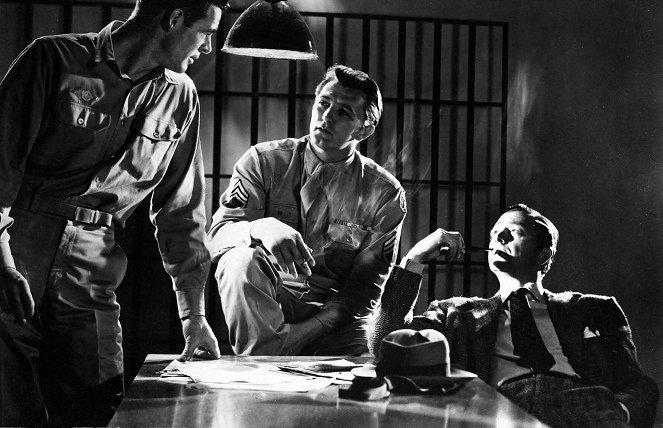
Heist and other crime films of the 1950s
The term "heist film" is used to describe films that revolve around big heists carried out by a team of cunning thieves, with the actual execution of the heist often accompanied by elaborate preparations, the dismantling of the relationships between the various actors, and at the end either a triumphant success or failure with fatal consequences. Early heist films were also made when Hollywood had to take a clearly negative stance towards criminal activities, and therefore most of them ended in failure for the thieves. The forerunner of this sub-genre was Raoul Walsh's White Heat (1949), whose main anti-hero was a mother-dependent gangster out for revenge, who in the course of the film, in addition to breaking out of prison, also carries out robberies with his gang. John Huston's The Asphalt Jungle (1950) was the definitive heist film with its story about a gang of robbers thwarted in the successful theft of a million dollars by their personal feuds.
It was soon followed by Armored Car Robbery (1950), in which a quartet of criminals unexpectedly complicate their ambitious plan to rob an armoured vehicle carrying half-million-dollar, and the British comedy The Lavender Hill Mob (1951), about a botched smuggling operation of stolen gold. A few years later, Stanley Kubrick's timeless The Killing (1956) enhanced the story of the planning and execution of a big heist with a non-linear narrative structure and alternating perspectives. The British tendency to mix a heist plot with humour was followed by The Ladykillers (1955), about a gang of burglars planning an elaborate heist in the sublet of an elderly landlady, in front of whom they pose as a string quartet. The crime comedy Ocean's Eleven was made in 1960, starring Frank Sinatra and his friends as a large gang of thieves who decide to rob the biggest casinos in Las Vegas.
Other exceptional crime films of the 1950s were William Wyler's Detective Story (1951), set in a police station over the course of a day, and The Desperate Hours (1955), about a trio of criminals fleeing from the police and taking a family hostage in their home. Equally notable was Billy Wilder's six-Oscar-nominated Witness for the Prosecution (1957), which capped the trial of a man suspected of murder with a series of surprising twists. Crime plots abounded in Alfred Hitchcock's thrillers Strangers on a Train (1951), about a chance encounter between two passengers who conspire to commit a pair of murders, Dial M for Murder (1954), which combined an attempt at a perfectly planned crime with a police investigation, and the four Oscar-nominated Rear Window (1954), about a couple who believe one of their neighbours has killed his wife. Otto Preminger's Anatomy of a Murder (1959) revolved around the case of a lieutenant accused of murdering a man who raped his wife.
Täydellinen rikos (1954)
Kuva © Warner Bros. Pictures
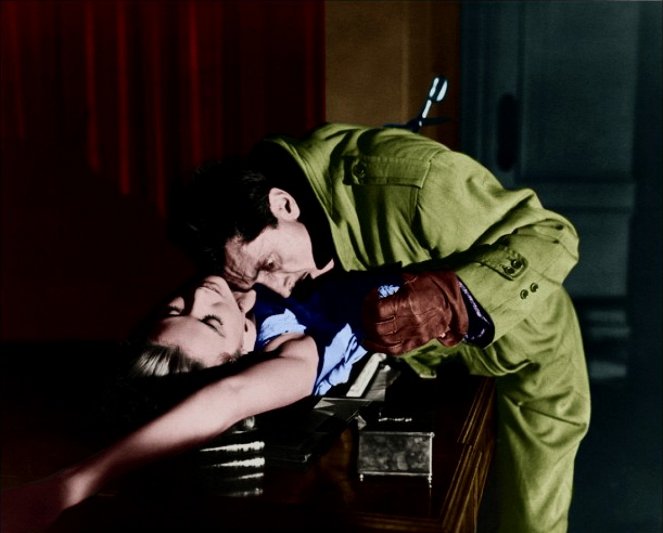
Post-noir, neo-noir and retro-noir
The peak period of film noir came to an end in the first half of the 1950s (one of the reasons for this was the advent of colour film and colour television), but films of this type continued to be made, albeit to a lesser extent. The last classic film noir is usually considered to be Orson Welles's Touch of Evil (1958), and later films are therefore labelled post-noir (or modern noir), which would later be divided into two groups: retro-noir and neo-noir. Retro-noir is used to describe films that attempt to faithfully emulate classic film noir from the 1940s and 50s and are set in that same era. In contrast, neo-noir is used for films that pay homage to classic film noir, may be visually and narratively inspired by the style, but do not attempt a faithful imitation and, moreover, are set in a completely different period, often at the time of their creation, but sometimes even in the future.
A typical example of retro noir is the eleven Oscar-nominated Chinatown by Roman Polanski (1974), which perfectly combined motifs from 1940s whodunits with the filmmaking trends and practices of the 1970s in a story of a private detective investigating a case of infidelity and getting involved in a web of fraud and political scandals. Later works of this kind include Curtis Hanson’s nine Oscar-nominated L.A. Confidential (1997), about a trio of detectives searching for the perpetrators of several murders, the Coen brothers' The Man Who Wasn't There (2001), about a hairdresser whose life begins to fall apart after an extortion attempt, and Michael Winterbottom's The Killer Inside Me (2010), about a deputy sheriff who leads a second life as a serial killer.
In contrast, films like Robert Altman's The Long Goodbye (1973) or Martin Scorsese's Taxi Driver (1976), both set in the 1970s, are classic representatives of neo-noir. This category also includes, among others, Lawrence Kasdan’s Body Heat (1981), about a lawyer who gets involved with a married woman and arranges for her to murder her wealthy husband, and Paul Verhoeven’s Basic Instinct (1992), about a police detective whom a murder suspect has wrapped around her finger, Sam Raimi's A Simple Plan (1998), whose characters' lives are turned upside down by the discovery of several million dollars in a crashed plane, and Christopher Nolan's Memento (2000), where the story a man with short-term memory loss seeking to avenge his wife's death was innovatively told from the end. Some dystopian science fiction films, such as Ridley Scott's Blade Runner (1982) and Alex Proyas's Dark City (1998), are often described as neo-noir, too.
Chinatown (1974)
Kuva © Paramount Pictures
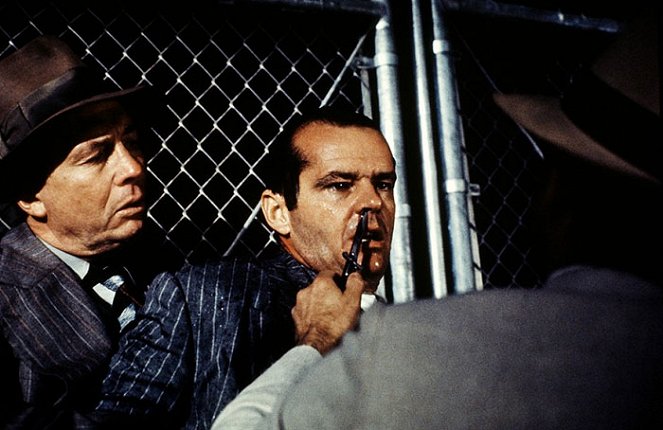
The 1960s and the end of classical Hollywood
The crime films of the 1960s drew on the genre and stylistic traditions of the preceding decades and were fond of looking to the past. Hollywood's unsuccessful efforts to respond to the significant decline in cinema attendance led to the collapse of the studio system at the end of the decade. This opened the door to the New Hollywood era, defined by the emergence of a new generation of filmmakers who revitalized the medium with a surge of vibrant creative energy and a passion for the artistic values of film. More space was also given to independent directors and producers, as well as to foreign films, which had a considerable influence on the shape of American cinema in those days. Arthur Penn's ten-Oscar-nominated Bonnie and Clyde (1967) was a breakthrough in this respect. Made shortly after the abolition of the Production Code, it offered audiences a level of realism, violence and sexuality never seen before. Inspired by the real-life love affair between a pair of criminals who became celebrities and symbols of the struggle against the system during the Depression, the story developed the tradition of the gangster film and enriched it with modern creative approaches, both technically (cinematography, editing) and in terms of ideas, foreshadowing the development of American cinema for the next decade.
The gangster genre was also fuelled by, among others, Underworld U.S.A. (1961), Point Blank (1967) and The St. Valentine’s Day Massacre (1967). The detective line was continued in films such as Frank Sinatra’s Tony Rome (1967), Lady in Cement (1968) and The Detective (1968). The standout prison film of this period was the four Oscar-nominated Cool Hand Luke (1967), directed by Stuart Rosenberg and starring Paul Newman as a likeable convict who makes several attempts to escape from captivity. The heist film genre was the basis for Gambit (1966) and How to Steal a Million (1966), which revolved around the theft of a rare statuette, and The Thomas Crown Affair (1968), about a suspicious insurance agent going after a bank robber. Other films that revolved around big heists include the British crime comedies The League of Gentlemen (1960), The Italian Job (1969) and Robbery (1967), directed by Peter Yates, who later went to Hollywood to make Bullitt (1968), the story of a police lieutenant searching for the killers of a gangster who had defected from a mafia organisation. Director Don Siegel drew attention to himself with The Killers (1964), Coogan's Bluff (1968) and Madigan (1968). Also notable was Richard Brooks's In Cold Blood (1967), based on the famous novel by Truman Capote, and Norman Jewison's In the Heat of the Night (1967), a five-Oscar winner dealing with racial issues that tells the story of Southern police officers who are helped by a black homicide specialist to investigate the death of a wealthy businessman.
Bonnie ja Clyde (1967)
Kuva © Warner Bros.
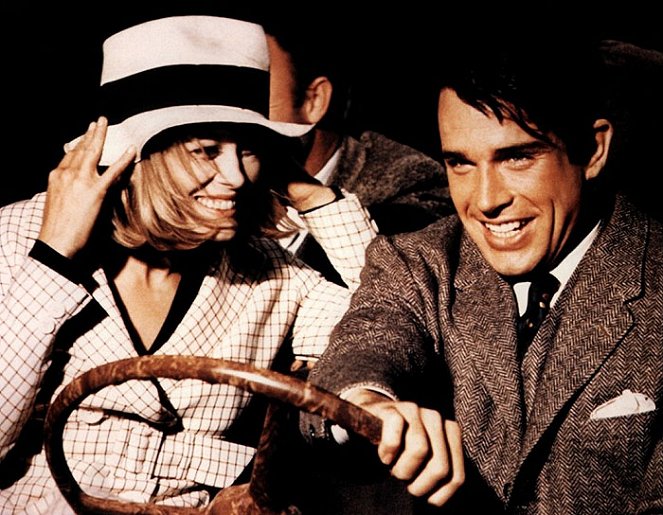
French crime films from the 1930s to the 1980s
Apart from the USA and the UK, France also has a relatively long history of crime cinema, with films of this genre being made already the 1930s, such as Marcel Carné's Daybreak (1939) and Jean Renoir's Night at the Crossroads (1932) and The Human Beast (1938). A number of French crime films fell into the category of film noir in their execution and plots, including Quay of the Goldsmiths (1947), Golden Marie (1952) and the prison film The Hole (1960). Rififi (1955), which became famous with its story about the robbery of a jewellery shop and the ensuing rift between rival gangs, was directed by American filmmaker Jules Dassin after having emigrated to France. One of the most famous faces of French crime cinema at the time was actor Jean Gabin, whose career lasted from the 1930s to the 70s – he played, for instance an influential gangster who decides to provide for his old age by stealing gold bars in Hands Off the Loot (1954), and later became famous for his role as Inspector Maigret in a series of detective stories (Inspector Maigret in 1958, Maigret and the St. Fiacre Case in 1959 and Maigret Sees Red in 1963).
These films subsequently became a precursor to the crime dramas of director Jean-Pierre Melville, who made a name for himself with Bob the Gambler (1956), Second Wind (1966), Le Samuraï (1967) and A Cop (1972), among others. Many crime films starred the icons of French cinema Jean-Paul Belmondo and Alain Delon, who met in the role of two criminals in Borsalino (1970). Belmondo also played thieves and crooks in The Brain (1969), The Burglars (1971), Incorrigible (1975) and Hold-Up (1985) and police commissioners in Fear Over the City (1975), Cop or Hood (1979) and The Outsider (1983). Delon also became famous for his roles in crime films such as The Sicilian Clan (1969), Two Men in Town (1973), Big Guns (1973), Flic Story (1975), Death of a Corrupt Man (1977), Three Men to Kill (1980), The Fighter (1983), Cop’s Honor (1985) and Let Sleeping Cops Lie (1988).
François Truffaut paid tribute to American gangster films with Shoot the Pianist (1960), in which he playfully combined several genres, and Jean-Luc Godard with Breathless (1960), which broke down cinematic conventions and made him a leading member of the French New Wave. Godard then succeeded with a deconstruction of a heist film called Band of Outsiders (1964) and with the detective sci-fi film Alphaville (1965), set in a dystopian future. Director Pierre Granier-Deferre became famous for his crime films The Violent People (1970), The French Detective (1975) and Widow's Walk (1987). Also worth mentioning is Claude Zidi's trilogy of crime comedies My New Partner (1984), My New Partner at the Races (1990) and Part-Time Cops (2003), starring acting legends Philippe Noiret and Thierry Lhermitte as police officers.
Pelko kaupungin yllä (1975)
Kuva © Agence Mediterraneens de Location de Films
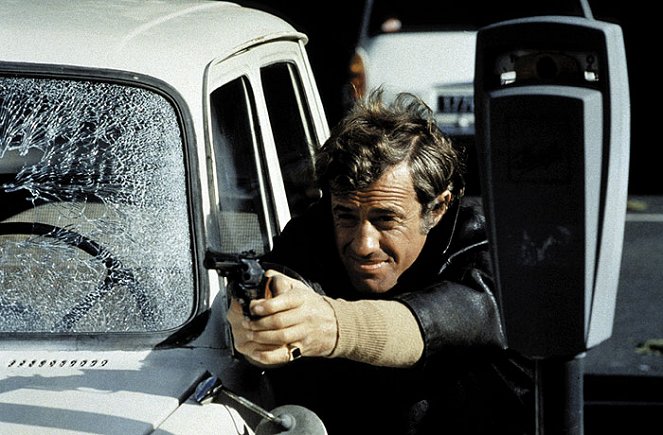
Famous British detectives
Some of the most famous and long-standing popular fictional private detectives originated in the UK – the novelist Agatha Christie created the characters of the peculiar Belgian detective Hercule Poirot and the elderly amateur sleuth Miss Marple, and Arthur Conan Doyle was the author of Sherlock Holmes, who already by 1923 had started in more than forty silent films, mostly shorts, and the first sound film featuring the famous detective was The Return of Sherlock Holmes (1929). Basil Rathbone played Holmes in fourteen films (e.g. 1939's The Hound of the Baskervilles, 1945's The Woman in Green and 1946's Terror by Night). Other actors that portrayed Holmes include, among others, Peter Cushing (The Hound of the Baskervilles, 1959), Robert Stephens (The Private Life of Sherlock Holmes, 1970) and Christopher Plummer (Murder by Decree, 1979). Holmes has also been the protagonist of many detective series and television films, played by actors such as Jeremy Brett, Ian Richardson and Benedict Cumberbatch. Director Guy Ritchie took an innovative approach in a pair of films, Sherlock Holmes (2009) and Sherlock Holmes: A Game of Shadows (2011), in which he transformed the title character played by Robert Downey Jr. into an action hero, while Ian McKellen took on the role of an ageing Sherlock Holmes in Mr. Holmes (2015).
Miss Marple was played by Margaret Rutherford in several films directed by George Pollock (e.g. Murder She Said in 1961, Murder at the Gallop in 1963 and Murder Most Foul in 1964). She was also played by Angela Lansbury in The Mirror Crack'd (1980) and portrayed on television by Helen Hayes, Joan Hickson, Geraldine McEwan and Julia McKenzie. Hercule Poirot first appeared in film in 1931, in Alibi, where he was portrayed by Austin Trevor. Since then more than a dozen actors have taken on the role across many films, TV movies and series, including Tony Randall (1965's The Alphabet Murders) and Albert Finney (1974's six-Oscar-nominated Murder on the Orient Express). He has also been played multiple times by Peter Ustinov (1978's Death on the Nile, 1982's Evil Under the Sun) and Kenneth Branagh (2017's Murder on the Orient Express, 2022's Death on the Nile). However, Poirot's most famous actor was David Suchet, who spent a quarter of a century working with him on Agatha Christie's Poirot series with a portrayal of the popular detective that became iconic.
Murder on the Orient Express (1974)
Kuva © Paramount Pictures / Joe Pearce
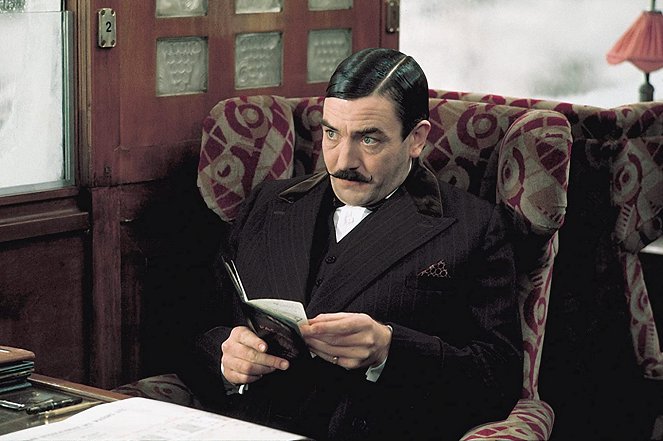
The new wave of crime films in 1970s Hollywood
The new era allowed filmmakers to deal with subjects that were taboo and forbidden in previous decades. Films became grittier, more violent, more realistic and more raw, as confirmed in the early 1970s by William Friedkin's The French Connection (1971), about a pair of detectives on the trail of heroin traffickers, or Don Siegel's cynical Dirty Harry (1971), in which Clint Eastwood plays a hard-nosed cop who disregards regulations and superiors tasked with catching a mysterious sniper. Director Martin Scorsese also gained a considerable reputation, first with Mean Streets (1973), about a group of small-town thugs, and then with the even more acclaimed Taxi Driver, starring Robert De Niro (1976), in which he looked at the morally decadent environment of New York through the eyes of a reclusive war veteran who befriends a twelve-year-old prostitute and decides to help her. Terrence Malick made a name for himself with Badlands (1973), about a couple on the run from the law, and Steven Spielberg worked with a similar theme in The Sugarland Express (1974).
The most notable audience and critical success, however, was the mafia epic The Godfather (1972), directed by Francis Ford Coppola and starring Marlon Brando and Al Pacino as father and son, which took in three of its eleven Oscar nominations, including Best Picture. Telling the story of mafia practices in the form of the influential criminal clan of Don Vito Corleone, the film depicted the complex web of relationships and internal rituals among the members of this closed gangster "family" and paved the way for other films about Italian-American mobsters. It was followed by The Godfather: Part II (1974), in which Al Pacino was joined by Robert De Niro in the second lead role. It would take in six of its eleven Academy Award nominations (again, including Best Picture), making it one of the most successful sequels of all time and the first ever to be awarded in a major category. Francis Ford Coppola completed the trilogy in 1990 with The Godfather: Part III after a long hiatus, with Al Pacino returning to his role as an ageing Michael Corleone.
Pacino also played the lead role in several films by Sidney Lumet; in Serpico (1973) he played an incorruptible cop fighting criminals and the corruption of his colleagues, and then he was cast in Dog Day Afternoon (1975), which garnered six Oscar nominations for its true story about a pair of thieves and one botched bank robbery. Seven golden statuettes went to The Sting (1973), starring Paul Newman and Robert Redford as con men who lure a feared gangster into a horse race hustle. In Roman Polanski's Chinatown (1974), Jack Nicholson took on the role of a private detective, and he would later direct its sequel, The Two Jakes (1990). Alan Parker's prison film Midnight Express (1978) was nominated for six statuettes, while Papillon starring Steve McQueen and Dustin Hoffman (1973), Escape from Alcatraz with Clint Eastwood (1979) and Brubaker with Robert Redford (1980) were also set in prisons.
Kummisetä osa II (1974)
Kuva © Paramount Pictures
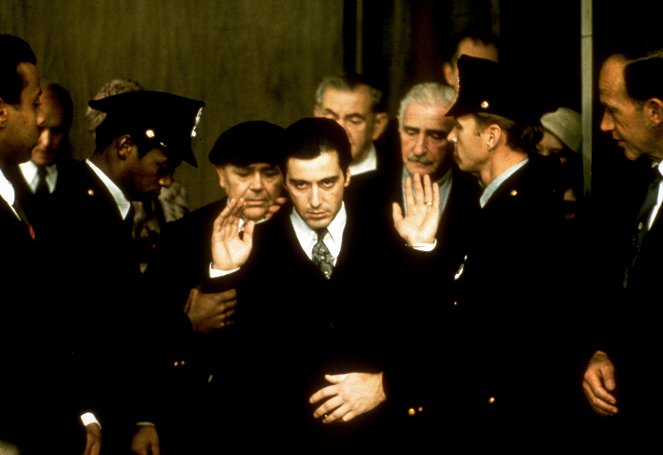
Gangster and other crime films of the 1980s and 90s
In 1983, Brian De Palma made Scarface, a remake of the 1932 gangster classic, moving the story of one mobster's rise and fall from Chicago to Florida and adding contemporary political and social themes such as drug trafficking and Cuban immigrant issues. This unusually vulgar and violent film starring Al Pacino inspired many other filmmakers to direct mafia epics. A few years later, Brian De Palma returned to the gangster theme with The Untouchables (1987), which earned four Oscar nominations for its 1930s tale of a group of cops chasing Al Capone, and Carlito's Way (1993), whose protagonist was unable to leave his criminal past behind. Sergio Leone made Once Upon a Time in America (1984) with Robert De Niro, a long-gestating monumental fresco about a New York gangster. In the early 1990s, in addition to The Godfather: Part III, there was also Martin Scorsese's Goodfellas (1990), one of the highlights of the genre, about the working lives of a trio of gangsters, which Scorsese followed with the equally popular Casino (1995), dealing with the backstage of a Las Vegas gambling sanctuary. Robert De Niro made his directorial debut with A Bronx Tale (1993), which explored the New York mafia milieu, and Mike Newell explored the same theme in Donnie Brasco (1997).
The theme of the mafia was visited by Barry Levinson's film about the founder of Las Vegas, Bugsy (1991), and also by brothers Ethan and Joel Coen, who, after their debut Blood Simple (1984) and Raising Arizona (1987), made Miller's Crossing (1990), set in the Prohibition era. They later became famous with Fargo (1996), the story of a botched job by two gangsters hired by a car dealer to kidnap his wife, and The Big Lebowski (1998), a crime-comedy in which several friends accidentally stumble into a blackmail case. David Lynch made history with his mystery-crime-drama Blue Velvet (1986), a satire of seemingly idyllic American small towns that hide a world of violence, psychopaths and sexual perversions beneath the surface. Quentin Tarantino became a cult filmmaker almost immediately after his debut, Reservoir Dogs (1992), a chaptered tale of a failed diamond heist that paid homage to many of the traditions of the crime genre and its exponents. He fully developed his directorial method in the patchwork Pulp Fiction (1994) and also in Jackie Brown (1997), about a fly attendant who decides to quit laundering money for her drug-dealing boss.
Alan Parker's Mississippi Burning (1988) was nominated for seven Oscars with a story of a pair of FBI agents investigating a triple murder against the backdrop of race riots. The British-American crime-comedy A Fish Called Wanda (1988), depicting the story of four robbers vying for a heist, was up for three statuettes. The five Oscar-winning crime-thriller directed by Jonathan Demme, The Silence of the Lambs (1991), in which Jodie Foster, as an FBI agent searching for a serial killer is forced to work with a cannibalistic psychiatrist played by Anthony Hopkins, was extremely successful. The seminal genre contributions of 1995 were Bryan Singer's The Usual Suspects, a two Oscar-winning account of an investigation into a smuggler's boat massacre, David Fincher's Se7en, in which investigators Brad Pitt and Morgan Freeman search for a murderer who kills according to the seven deadly sins, and Michael Mann’s Heat, starring Al Pacino and Robert De Niro as two age-old rivals: a police detective and the leader of a gang of thieves.
A total of eleven Oscar nominations were shared between two prison films directed by Frank Darabont: The Shawshank Redemption (1994), which dealt with the fate and escape of a wrongly convicted bank clerk, and The Green Mile (1999), about a former warden recalling his experiences with prisoners and colleagues. Point Break (1991), about an FBI agent who infiltrates a robbery ring of surfers, True Romance (1993), which featured a lovelorn couple battling the drug underworld, Natural Born Killers (1994), in which a pair of lovers on the run from the law leave one dead body after another, and Payback (1999), starring Mel Gibson as a vengeful gangster who is robbed by his cronies, also won many fans.
Pulp Fiction - Tarinoita väkivallasta (1994)
Kuva © Miramax Films
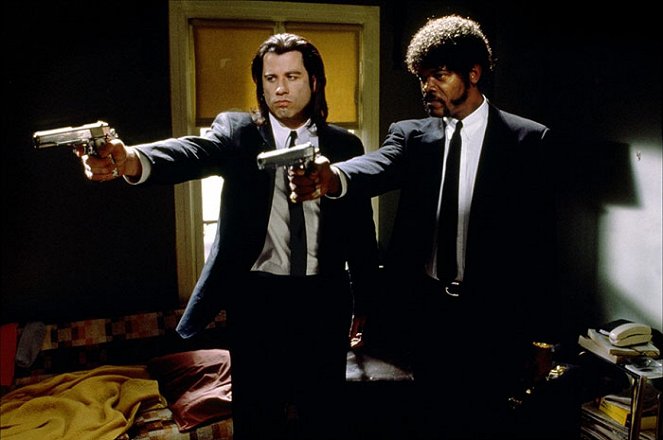
Nordic detective films and other European crime films since the 1990s
The most notable Scandinavian crime films of the 1990s include the Swedish The Hunters (1996), about a policeman on the trail of his brother, the leader of a poaching gang, the Norwegian Insomnia (1997), about a pair of detectives whose murder investigation is complicated by the insomnia of one of them, and the Danish Pusher (1996), dealing with the fate of a dealer trying to pay off a dangerous drug baron. Later, the Danish Flickering Lights (2000), a crime-comedy about a group of Copenhagen thieves, and the darkly humorous In Order of Disappearance (2014), from Norway, depicting the revenge journey of a snow-plow driver whose son was killed by mobsters, became prominent representatives of the genre.
Parallel to the popularity of Nordic crime and detective novels, their film adaptations came to the fore after 2000. Iceland's Jar City (2006) intertwined a murder investigation with the misuse of genetic information in two story lines. The Millennium trilogy (2009), consisting of The Girl with the Dragon Tattoo, The Girl Who Played with Fire and The Girl Who Kicked the Hornet's Nest, focused on a computer hacker who befriends an investigative journalist while investigating a woman's long-ago disappearance. Based on a Norwegian book, Headhunters (2011) successfully combined suspense with black humour in a bloody story of a talent scout and an art thief who was after one of his robbed victims. In Denmark, a film series about a pair of Special Branch detectives reopening old unsolved cases became a huge hit with The Keeper of Lost Causes (2013), The Absent One (2014), A Conspiracy of Faith (2016) and Journal 64 (2018) . Also worth mentioning is the multi-part film series about detective Varg Veum, which began with Bitter Flowers (2007).
In Italy, crime films were extremely popular at the turn of the 1960s and 70s (see, for example, The Violent Four from 1968, Investigation of a Citizen Above Suspicion from 1970 or Execution Squad from 1972) and gangster films inspired by the activities of the Sicilian mafia were also common (Illustrious Corpses from 1976, Corleone from 1978 and later, for example, The Bodyguards from 1993). Several directors followed this trend in the new millennium: Paolo Sorrentino (The Consequences of Love, 2004), Matteo Garrone (Gomorrah, 2008), Stefano Sollima (Suburra, 2015) and Marco Bellocchio (The Traitor, 2019), among others. In France, the tradition of the crime genre continued with The Crimson Rivers (2000), which investigated several murders in the French Alps, Department 36 (2004), about a pair of policemen searching for the perpetrators of a series of armed robberies, and the two-part Mesrine (2008), which told the story of one of the greatest French gangsters of all time.
Public Enemy No. 1 Part 1 (2008)
Kuva © Hollywood Classic Entertainment
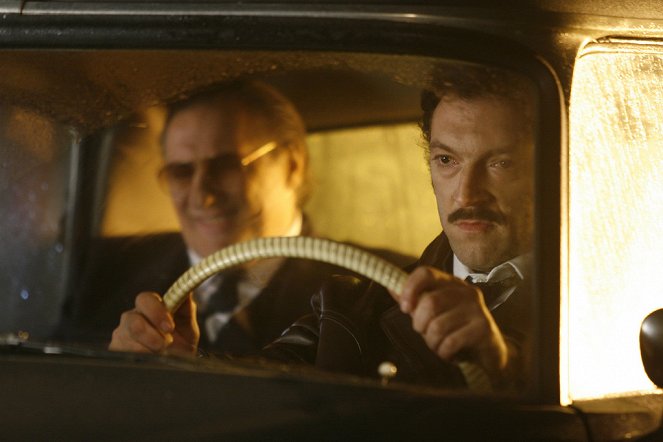
Japanese and other Asian crime films
American crime dramas inspired some of Akira Kurosawa's films, such as The Bad Sleep Well (1960) and High and Low (1963), which was also an adaptation of an American detective novel. After that, gangster and yakuza films took hold in Japan, including Tokyo Drifter (1966) and Branded to Kill by Seijun Suzuki, and Battles without Honor and Humanity (1973) and Graveyard of Honor (1975) by Kinji Fukasaku. Later, the renowned renaissance filmmaker Takeshi Kitano would become one of the most famous Japanese directors in the genre with films such as Fireworks (1997), Brother (2000) and Outrage (2010), among others.
In Hong Kong, the mafia action thrillers directed by John Woo A Better Tomorrow (1986), The Killer (1989), Bulllet in the Head (1990) and Hard Boiled (1992) became hits. Jackie Chan's Police Story (1985) and Crime Story (1993) were also popular, and the series that began with Infernal Affairs (2002), in which cops and mobsters each send a cadet to infiltrate the other's camp, became internationally famous (thanks in part to Martin Scorsese's 2006 American remake). The Hong Kong film City on Fire (1987), about a police agent seizing the opportunity to infiltrate a gang of dangerous jewel robbers, was a breakthrough in the field of heist films.
In Thailand, crime films such as Bangkok Dangerous (2000), whose deaf protagonist decides to break out of his underworld career for love, and the heist film Bad Genious (2017), in which the plot revolved around cheating on high school tests, were big hits. In South Korea, some of the most acclaimed crime films were directed by Chan-wook Park (Sympathy for Mr. Vengeance from 2002 and Lady Vengeance from 2005) and Joon-ho Bong (Memories of Murder from 2003 and Mother from 2009). Also popular were the gangster and detective films A Bittersweet Life (2005), The Chaser (2008), The Man from Nowhere (2010), I Saw the Devil (2010) and The Yellow Sea (2010).
The crime genre in India has always been dominated by two types of films: stories of rural bandits (1975's Flames of the Sun, 1994's Bandit Queen) and gangster films set in the Mumbai underworld (1973's Zanjeer, 1987's Nayakan, 2002's Company, and 2013's Shootout at Wadala). Also worth mentioning are Anurag Kashyap's Black Friday (2004), based on true events about the investigation of a series of terrorist attacks in Mumbai, and the two-part Gangs of Wasseypur (2012), an epic saga dealing with the fate of three generations of the coal mafia in northern India.
Memories of Murder (2003)
Kuva © CTV International
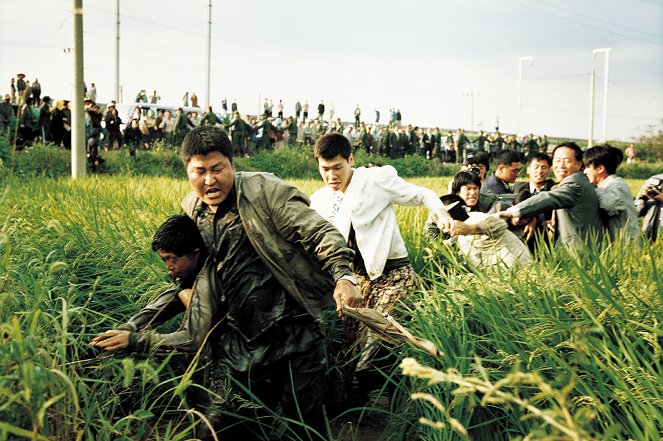
American and British crime films of the new millennium
British director Guy Ritchie successfully established himself in the gangster genre with his debut Lock, Stock and Two Smoking Barrels (1998), followed by Snatch (2000), which dealt with the theft of a giant diamond, and then returned to the theme of the criminal underworld in RocknRolla (2008) and The Gentlemen (2019). Martin Scorsese continued making mafia dramas. After Gangs of New York (2002), which was based on a 19th century street gang war, he directed The Departed (2006), a remake of the Hong Kong crime-thriller Infernal Affairs. He would then go on to direct the stock market capitalist crime-drama The Wolf of Wall Street (2013), which instead of the rise and fall of a gangster follows the fate of a financial stock swindler, and the mafia epic The Irishman (2019), in which he had his favourite actors Robert De Niro, Al Pacino and Joe Pesci, rejuvenated by digital technology. Other examples of gangster films include Sam Mendes's Road to Perdition (2002), Matthew Vaughn's Layer Cake (2004), Ridley Scott's American Gangster (2007), Michael Mann's Public Enemies (2009), John Hillcoat's Lawless (2012), Ruben Fleischer's Gangster Squad (2013), Scott Cooper's Black Mass (2015), and Ben Affleck's Live by Night (2016).
Steven Soderbergh directed the four-Oscar-winning crime-thriller Traffic (2000), which looked at the drug trade from several angles, and then went on to direct the crime-comedy Ocean's Eleven (2001), a remake of the namesake film from 1960. He stayed with the sub-genre of heist films while working on the sequels Ocean's Twelve (2004) and Ocean's Thirteen (2007), and then on Logan Lucky (2017). After making a name for himself as the screenwriter of the crime-thriller Training Day (2001), David Ayer directed Harsh Times (2005), Street Kings (2008) and End of Watch (2012), all of which featured police officers fighting crime on the streets of Los Angeles. For his part, David Cronenberg directed A History of Violence (2005), the story of a man with a criminal past, and Eastern Promises (2007), which explored the world of Russian mafia clans in London. In Catch Me If You Can (2002), Steven Spielberg captured the fate of a notorious fraudster and forger, David Fincher told the story of investigators searching for a notorious serial killer in Zodiac (2007), and Nicolas Winding Refn portrayed the life of Britain's most famous prisoner in the crime-drama Bronson (2008).
Casey Affleck played a Boston detective in his brother's film Gone, Baby, Gone (2007), Ryan Gosling portrayed a hired driver for criminal gangs in Drive (2011), and Jake Gyllenhaal took on the role of a reporter filming videos of criminal activities, police interventions and tragic accidents for television in the crime-thriller Nightcrawler (2014). The Coen brothers succeeded at the Oscars with No Country for Old Men (2007), a western-themed crime-thriller about the discovery of a briefcase full of money, which took in four of its eight nominations. Five Oscar nominations went to David Fincher's The Girl with the Dragon Tattoo (2011), while David O. Russell's American Hustle (2013), about the FBI working with crooks to hunt down a corrupt politician, was up for ten statuettes. In Brugges (2008) added black humour to the crime genre with its story of two hiding assassins set in the Christmas season, and so did The Nice Guys (2016), about two men falling into the mafia underworld in search of a missing girl. Also worth mentioning are the heavily stylized Sin City (2005), one of the most faithful comic book adaptations of all time, Now You See Me (2013), whose heroes are a group of top illusionists performing heists as part of their magic acts, and Baby Driver (2017), whose editing was imaginatively subordinated to a song soundtrack.
The Gentlemen (2019)
Kuva © STX Entertainment
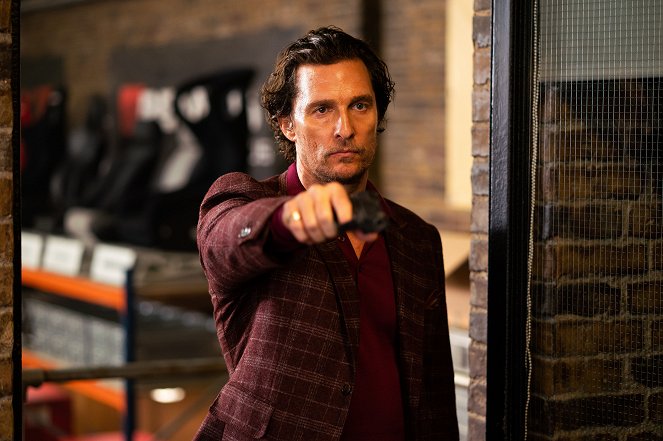
Crime series across the ages
Crime series were very popular already at the beginning of television in the 1950s, and their king was Dragnet (1951-1959), which would receive several remakes in the following decades. In its time, it defined the shape of the police crime series, including the narrative structure, the archetypes of the main characters, and the portrayal of their jobs and their environment, setting the tone for many of its successors. Crime series would become increasingly popular, leading to their dominance over other genre television. Other popular series of the 1950s include Highway Patrol (1955-1959), Markham (1959-1960) and The Untouchables (1959), while the 1960s and 70s belonged to police series such as The Fugitive (1963-1967), Adam-12 (1968-1975), The F.B.I. (1965-1974), Hawaii Five-O (1968-1980) and The Streets of San Francisco (1972-1977).
In the 1970s, police series such as Starsky and Hutch (1975-1979), Police Story (1973-1987) and the British The Professionals (1977-1983) were joined by detective series, the most popular of which was Columbo (1971-2003), though Kojak (1973-1978) and Barnaby Jones (1973-1980) also had their fans. The 1980s saw, among others, the crime series Miami Vice (1984-1989) and Jump Street 21 (1987-1991) and, in the UK, Taggart (1983-2010) and The Bill (1984-2010). Also popular were the trilogy of series The Adventures of Sherlock Holmes (1984-1985), The Return of Sherlock Holmes (1986-1988) and The Case-Book of Sherlock Holmes (1991-1993). In the 1990s, Agatha Christie's Poirot (1989-2013) became a detective star, but TV screens also featured series such as Law & Order (1990-2010), NYPD Blue (1993-2005), Homicide: Life on the Street (1993-1999), JAG (1995-2005) and The F.B.I. Files (1998-2006), as well as the mafia saga The Sopranos (1999-2007) and the German police series Inspector Rex (1994-2004) and Alarm for Cobra 11 (since 1996). David Lynch himself was behind the mystery-crime series Twin Peaks, the first two seasons of which became iconic after their release in 1990 and were followed by a third season in 2017.
Shortly after the turn of the millennium, TV screens featured the heroes of The Shield (2002-2008), Without a Trace (2002-2009), Cold Case (2003-2010), NCIS: Naval Criminal Investigative Service (since 2003) and the thematic trilogy of CSI: Crime Scene Investigation (2000-2015), CSI: Miami (2002-2012) and CSI: NY (2004-2013). Also popular was the heroine of the crime-series Veronica Mars (2004-2019) and the series The Wire (2002-2008), Criminal Minds (since 2005), Bones (2005-2017) and The Closer (2005-2012). Dexter (2006-2013) and Hannibal (2013-2015), in contrast, were told from the perspective of villains, while Sons of Anarchy (2008-2014) dealt with the stories of a biker gang in the world of arms dealing, and Boardwalk Empire (2010-2014) was set in the urban gangster underworld during Prohibition. Among the vast number of other popular crime series of various subtypes, we can highlight, for example, Castle (2009-2016), Luther (2010-2019), Brooklyn Nine-Nine (since 2013) and American Crime Story (since 2016).
Sherlock Holmes received a new treatment in the Sherlock series (2010-2017), while Mob City (2013) and the British Peaky Blinders (2013-2019) visited the world of the mafia. The prison theme was explored in Prison Break (2005-2017), the story of a man who was imprisoned in order to help his innocent brother escape, and so did the Australian series Wentworth (since 2013), set in a women's prison. Breaking Bad (2008-2013) was a groundbreaking series about a dying high school teacher who teams up with a former student to make and sell meth, and was later followed by the spin-off Better Call Saul (from 2015). Other seminal series in the crime genre include True Detective (2014-2019), Fargo (since 2014), Mr. Robot (2015-2019), Mindhunter (2017-2019), and Narcos (2015-2017), a real-life saga about the world of Colombian drug gangs.
Filmmaniak
Parhaat rikoselokuvat
Avain pakoon (1994) |
Vihreä maili (1999) |
Seitsemän (1995) |
Kummisetä (1972) |
Valamiesten ratkaisu (1957) |
Pulp Fiction - Tarinoita väkivallasta (1994) |
Kummisetä osa II (1974) |
Yön ritari (2008) |
Uhrilampaat (1991) |
Puhallus (1973) |
| Kaikki parhaat rikoselokuvat |

